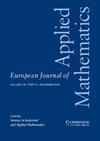关于具有质量作用或标准发生机制的退化反应-扩散流行病模型
IF 1.1
4区 数学
Q1 MATHEMATICS, APPLIED
引用次数: 0
摘要
在本文中,我们考虑了具有大规模行动或标准发病机制的反应扩散流行病模型,并研究了限制人口流动对疾病传播的影响。我们将易感人群或感染人群的扩散率设为零,并研究相应的退化反应-扩散模型。我们研究这些模型全局动力学的主要方法是构建微妙的 Lyapunov 函数。我们的研究结果表明,限制易感者或感染者的移动所产生的后果取决于传播机制、模型参数和人口规模。本文章由计算机程序翻译,如有差异,请以英文原文为准。
On degenerate reaction-diffusion epidemic models with mass action or standard incidence mechanism
In this paper, we consider reaction-diffusion epidemic models with mass action or standard incidence mechanism and study the impact of limiting population movement on disease transmissions. We set either the dispersal rate of the susceptible or infected people to zero and study the corresponding degenerate reaction-diffusion model. Our main approach to study the global dynamics of these models is to construct delicate Lyapunov functions. Our results show that the consequences of limiting the movement of susceptible or infected people depend on transmission mechanisms, model parameters and population size.
求助全文
通过发布文献求助,成功后即可免费获取论文全文。
去求助
来源期刊
CiteScore
4.70
自引率
0.00%
发文量
31
审稿时长
>12 weeks
期刊介绍:
Since 2008 EJAM surveys have been expanded to cover Applied and Industrial Mathematics. Coverage of the journal has been strengthened in probabilistic applications, while still focusing on those areas of applied mathematics inspired by real-world applications, and at the same time fostering the development of theoretical methods with a broad range of applicability. Survey papers contain reviews of emerging areas of mathematics, either in core areas or with relevance to users in industry and other disciplines. Research papers may be in any area of applied mathematics, with special emphasis on new mathematical ideas, relevant to modelling and analysis in modern science and technology, and the development of interesting mathematical methods of wide applicability.

 求助内容:
求助内容: 应助结果提醒方式:
应助结果提醒方式:


